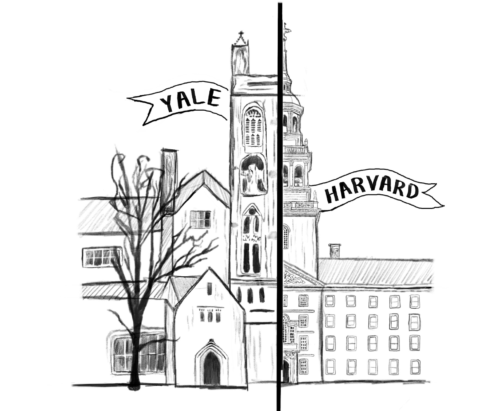“Say WHAT? SAY-BROOK!”
From the nostalgic cheer of Saybrook College to the newer formation of Benjamin Franklin College, Yale’s housing system has evolved to aid in the growth of its student body through forging unique social and intellectual communities. And although Harvard’s fated rivalry often leads to the condemnation of everything associated with Yale University, their housing system may be a model we should emulate.
Though Harvard first-years relish in the spring semester ritual of the infamous Housing Day before discovering their home for their next three years on campus, Yale freshmen receive their residential colleges a few weeks before move-in, reaping the benefits of having a community from day one. This year, incoming Yale students were seen rushing to social media platforms once assignments were released, hoping to bond with incoming first-years over their shared future living accommodations. Swarms of “Davenport,” “Trumbull,” “Branford,” fill the social media feeds of incoming students, as future Yalies revel in the strong sense of community the school cultivates so early on.
From the Red Lions in Timothy Dwight to the Spiders at Jonathan Edwards, Yale’s residential college mascots are the face of the fierce and traditional camaraderie within each building and between its students. A 2004 Harvard review even acknowledged the benefits of such a system, commenting that Harvard should adopt a similar practice to improve the College’s “sense of community.” Though both Harvard and Yale have their students complete surveys about their living preferences and daily habits to ensure they are assigned compatible suitemates, Yale’s housing system goes one step further.
From Berkeley to Brandord, Yale’s fourteen residential colleges each boast unique personalities that offer entire houses of similar peers. Enjoying a black box theater movie night at Pauli Murray or a late-night band session at Benjamin Franklin’s recording studio poses infinite excitement and ease, especially during a freshman’s first few weeks on campus where friends and the social scene remain nebulous.
Recognizing these benefits and seeing the clear discrepancies at Harvard, alumni have commented on the lack of organized social life in the Yard, with a poor party scene posing inevitable isolation for the College’s newest students. The communal anxiety only worsens as the Thursday before spring break approaches, with Harvard’s students often scrambling to solidify their blocking group amongst a class of around 2,000 students. Furthermore, with “linking” groups (a process where two blocking groups of up to eight could match with one another to ensure they were placed in the same neighborhood), now suspended for the upcoming 2024 housing season, the pressure to only fraternize with select students in close proximity increases.
Harvard’s present housing system poses a social nightmare for many: the question of who students live with often trumps the excitement of house assignments. Sometimes it takes months to determine and form blocking groups at the College, and the process is often regarded as stressful. Unfortunately, this pressure rushes students into finding a defined friend group when first stepping foot on campus, inexorably leading to artificial relationships and last-minute exclusion.
Yale, in contrast, has students select sophomore roommates from their respective residential colleges, offering the chance to pick from a significantly smaller pool of peers with seemingly compatible living companions. It is important to note that this predetermined system of housing does not pose unwanted dividers, with Yale students commenting on the campus’ range of classes and clubs presenting enough inclusivity to allow for a thriving social life both within and outside one’s residential college.
Beyond the clear social and emotional benefits of the Yale residential college system, their model is more academically pragmatic. If Harvard adopted the Yale model, first-years would have the freedom to utilize house-specific advising resources. Tutors and graduate students from almost every department often live in the houses for an entire year, allowing students to access mentorship before having to officially declare their college concentration, presenting the opportunity to deepen a student’s exploration of curricular offerings.
From upperclassmen mentorship and a place to call home from the start, Yale’s housing system offers a community and peace of mind that Harvard College lacks. If the University seeks to improve both first-years’ sense of belonging and upperclassmen camaraderie, they should prioritize a shift to Yale’s residential college model. Otherwise, being Bulldogs might just become more desirable than Crimson.
Sara Kumar ’27 (sjkumar@college.harvard.edu) still believes in Yuck Fale.

